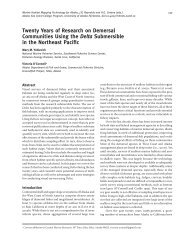724_Final Report.pdf - North Pacific Research Board
724_Final Report.pdf - North Pacific Research Board
724_Final Report.pdf - North Pacific Research Board
You also want an ePaper? Increase the reach of your titles
YUMPU automatically turns print PDFs into web optimized ePapers that Google loves.
migration, or how the diets of juveniles and non-breeding adults compare with those of breeding adults or<br />
chicks (Barrett et al. 2007). Because FAs provide information over a longer period of time, it may be<br />
possible to get information about diets during non-breeding seasons (e.g., describe the diet during<br />
migration by sampling birds at arrival to breeding sites). However, in order to do this, captive studies<br />
must be performed to determine the period of time over which the diet can be back calculated. This non-<br />
lethal technique of FA signature analysis may be particularly useful in estimating the diets of species of<br />
conservation concern.<br />
The spectacled eider Somateria fischeri and Steller’s eider Polysticta stelleri were listed as<br />
threatened under the provisions of the U.S. Endangered Species Act in the 1990s (Federal Register 1993,<br />
1997). Reasons for the population declines remain unknown, but changes in the marine environment and<br />
available food resources may be limiting the recovery of both species (U.S. Fish and Wildlife Service<br />
1996, 2002). Spectacled and Steller’s eiders use a range of marine habitats for staging, molting and<br />
wintering (Petersen et al. 2000, Fredrickson 2001). Because eiders winter and stage in marine habitats, the<br />
breeding outcome likely depends on availability of adequate marine resources, but information about<br />
timing and sources of critical nutrient acquisition to reproduction is lacking for the threatened eider<br />
species in the <strong>North</strong> <strong>Pacific</strong>. Also, the extent to which spectacled and Steller’s eiders use marine versus<br />
terrestrial nutrients for reproduction is unknown. Determining the diet preferences and foraging habitat<br />
associations of these eiders in relation to seasonal and life history stages will provide information to help<br />
identify and characterize critical habitats of these threatened breeding populations. Our goal was to<br />
validate QFASA to estimate the diets in captive spectacled and Steller’s eiders. We assessed the<br />
quantitative characteristics of FA deposition and developed CCs for individual FAs to account for eider<br />
lipid metabolism. We used simulation studies using the captive eider diet to evaluate the reliability with<br />
which diet items could be distinguished in the model. <strong>Final</strong>ly, we tested the model and CCs by estimating<br />
the diets of experimentally fed captive eiders.<br />
10



